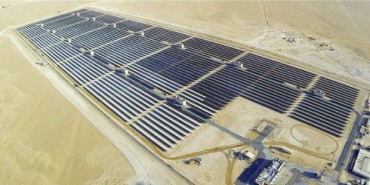 One high-tech polymer start-up has developed a coating to solve the problem.
One high-tech polymer start-up has developed a coating to solve the problem.
The huge and visionary Desertec Industrial Initiative (Dii) plan to ship vast amounts of solar to Europe has one glaring potential weakness. Dust. Deserts have all the sun that is needed to power vast cities, and recently, the 3rd Desertec deal was signed, but they also have dust. Lots of it. And little water to clean it.
Just one month’s dust accumulation in desert conditions can reduce a panels output by 35%, and some even warn that water-intensive CSP is impossible for desert solar.
So developing dust-resistant solar will be the next Big Thing.
Indeed, according to its German mirror manufacturer Flagsol, the water usage for cleaning the solar mirrors at Kuraymat – Egypt’s groundbreaking solar-gas hybrid power plant – is 39,000 litres a day. These are huge sun catcher machines. Each of the parabolic troughs is six meters tall (18 ft) and there are 6,000 of them.
Keeping solar panels or mirrors clean in the desert is the main challenge, according to Bodo Becker, the operations manager at Germany’s Flagsol, of its plants in the region Egypt. “Due to the dusty conditions, we are witnessing about 2% degradation every day in performance, so we need to clean them daily. We use about 39 cubic metres of demineralised water each day for cleaning across the whole site.”
Making matters worse is that, in addition to the dust that blows in from the desert, the relatively high humidity helps turn fine dust into a sort of crust. “It makes the dust stick,” says Lana el Chaar, an assistant professor in the electrical engineering department at Abu Dhabi’s Petroleum Institute. “Fans cannot blow it off.”
High tech researchers around the world are looking for solutions to the problem. Georgia Tech is working on one nanostructured superhydrophobic solution, but it is very expensive.
Mars has the largest dust storms in the solar system (that we know of – yet!) and Boston University researchers are working on a Mars Mission inspired solution. But again: very expensive. Even German renewables giant Siemens in partnership with Abu Dhabi’s visionary Masdar have just broken into the sand resistant solar business, as noted by Green Prophet’s Taffline Laylin.
And last year, GlassPoint returned from the region with another dust-resistant solution: put the solar in a glass house. Of course, this is best for smaller solar installations.
But a chemicals spin-out from the University of Leeds Chamelic, that is in the business of making high-tech poymer coatings, may have just come out with a much more market-ready solution for utility-scale solar.
Chamelic has developed an ultra thin surface treatment that can just be applied to the routine wash, that can repel dust for up to 8 weeks.
Tested in the similar fine dust desert in Arizona, the coating – which leaves no residue – performed miracles.
Independent measurements found that 100% of the light was still reflected back from the mirrors after application. In simulated harsh desert conditions, with temperatures of 30 degrees Centigrade, in dust storms with wind speeds of between 20 and 40 miles an hour, untreated mirror surfaces lost over 9% of production. Chamelic solution, in a water base, lost less than 2%, and in an alcohol base, lost less than 1%.
The company is eagerly looking forward to a commercial solar plant trial in harsh desert conditions. Got dust? Flagsol – meet Chamelic!
Related stories:
Masdar and Siemens Team Up to Develop Sand-Resistant Solar Panels
Desertec Begins: 500 MW Moroccan Solar in 2012
Martian Technology Proposed For Zapping Dust from Solar



